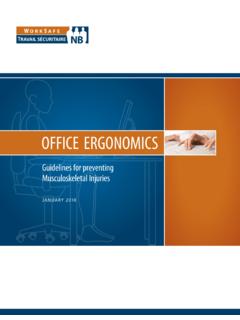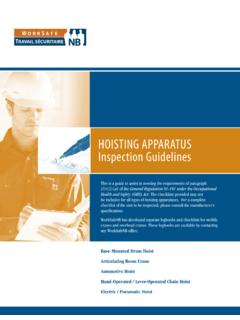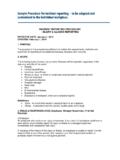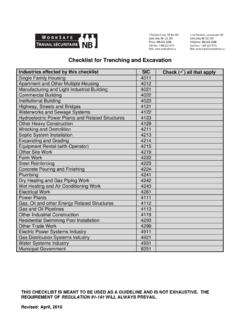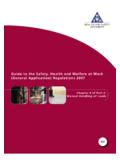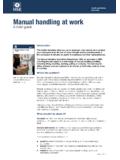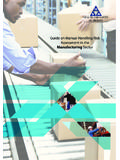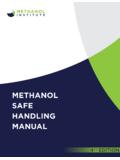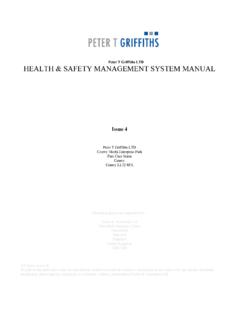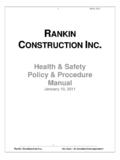Transcription of ERGONOMICS GUIDELINES FOR MANUAL …
1 ERGONOMICS GUIDELINES FOR MANUAL HANDLING2nd EDITION (2010)Reprinted August 2011 ERGONOMICS GUIDELINES FOR MANUAL handling ERGONOMICS is the science of studying people at work and then designing tasks, jobs, information, tools, equipment, facilities and the working environment so people can be safe and healthy, effective, productive and comfortable. ( ERGONOMICS Design GUIDELINES , Auburn Engineers, Inc., 1998)INTRODUCTION ..3 Stages of cumulative MSIs ..3 Why is MANUAL handling a problem? ..4 Definition ..4 How to use this document ..5 MANUAL handling checklist ..6 MSI PREVENTION: FINDING A SOLUTIONThe commitment ..7 Engineering out of the problem ..7 Providing education ..7 Potential solutions ..8 Forceful exertion ..8 Posture ..10 Repetition ..12 BIBLIOGRAPHY ..13 APPENDIX A ..14 APPENDIX B ..16 APPENDIX C ..17 Blank MANUAL handling checklist ..18 AcknowledgmentSpecial thanks to the Canadian Centre for Occupational Health and Safety and to WorkSafe Western Australia for granting permission to use their graphic , we thank all the New Brunswick employers and employees who provided feedback during the pilot phase of this document represents best practices to prevent MANUAL handling injuries and other business losses due to MANUAL handling .
2 Information contained in this document may change over time as new research and studies are done in the field of ERGONOMICS . This document is not designed to replace a professional ERGONOMICS 11228 is not a regulatory requirement. WorkSafeNB, 2010 TABLE OF CONTENTS3 ERGONOMICS GUIDELINES FOR MANUAL HANDLINGINTRODUCTIONAs part of its ERGONOMICS strategy, WorkSafeNB has developed ERGONOMICS GUIDELINES for MANUAL handling . This booklet is designed to be used by all industries, and to help Joint Health and Safety Committees, supervisors and management prevent musculoskeletal musculoskeletal injury (MSI) is an injury or disorder of the muscles, tendons, ligaments, joints, nerves, blood vessels or related soft tissue arising from exposure to risk factors such as awkward postures, repetitive motions and forceful exertions. The injury can be acute or of cumulative MSIs: Stage 1: Mild discomfort, present while working, but disappears when not working.
3 Does not affect work performance or daily living tasks. Completely reversible. Stage 2: Pain is present while working and continues when not working. Begins to affect daily living tasks. Employees sometimes take non-prescription pain medications. Completely reversible. Stage 3: Pain is present all the time. Employees seek medical attention. May not be able to complete simple daily tasks. May not be completely reversible to reach full recovery. Employee participates in the workplace accommodation the early stage, employees should communicate the increasing pain to their immediate supervisor. This is a great opportunity to prevent the MSI from Discomfort Survey found in Appendix A is a great tool to help employees report early signs and symptoms of MSI to their supervisor. 4 ERGONOMICS GUIDELINES FOR MANUAL HANDLINGWhy is MANUAL handling a problem?Across Canada, many workplaces are experiencing an increase in the number of MSIs.
4 New Brunswick statistics for 2007 reveal that MSIs account for 38% of all long-term claim costs. Approximately 70% of all MSIs are injuries to the back and New Brunswick, the following section of General Regulation 91-191 applies to handling an object or material:91-191 Section 52 Where the health or safety of an employee handling an object or material may be endangered, an employer shall ensure that (a) Adequate and appropriate equipment is provided to the employee and is used by the employee for lifting and moving the object or material, and(b) The employee is instructed as to the appropriate method of lifting and moving objects and material. DefinitionManual material handling includes any tasks which require a person to lift, lower, push, pull, hold or carry any object or GUIDELINES FOR MANUAL HANDLINGHow to use this documentStep 1 The first part of this document involves using a checklist to identify high-risk MANUAL handling tasks.
5 This identification process emphasizes lifting, lowering, pushing and pulling activities by assessing the following factors: Forceful exertion Awkward posture Repetitive motionWhen quantifying the level of exposure for these primary risk factors you will need to consider measuring peak force, sustained force, weight of object, cumulative weight handled, various joints angles, duration of exposure, frequency, working height, workstation dimensions affecting body position, productivity, process of identifying risk factors and quantifying the level of exposure will require intensive work upfront, but will provide tremendous benefits in terms of finding solutions that address the root cause of the you are not sure where to start, simply select a task that has any of the following characteristics: Task requires high physical exertions while performing MANUAL handling activities. Employee has a score greater than five on the Discomfort Survey.
6 Employee has had an MSI in the past while performing the task in the past. Step 2 The second part involves using the potential solutions section to develop an action plan with detailed solutions to eliminate or reduce the high-risk MANUAL handling tasks. For each Yes answer on the checklist, consult the potential solutions for examples of ways to reduce the risk of injury. Use these examples as a starting point for brainstorming and developing your own action and involve the employee when completing the checklist for the task you have identified. To improve to improve the accuracy and consistency of your results, be sure to evaluate the most strenuous and physically-demanding portion of the task. Each Yes answer indicates a risk of an MSI or a sub-optimal condition. Include all meaningful comments for each item and answer NA if the question does not GUIDELINES FOR MANUAL HANDLINGMANUAL handling CHECKLISTR emember to check for a Physical Demands Analysis or Task Information Sheet.
7 They can help you fill the checklist pushing and pulling forces can be measured with a special gauge, which takes all the variables into account (weight, friction, acceleration).Task #1 Task #2 Task #3 Forceful exertionsCheck only if Yes YesYes1. Is the weight of the object lifted more than 25 kg male/ 15 kg female?2. Is the initial pushing or pulling force exerted more than 320 N male/220 N female? (10 newtons ~ 1 kg)3. Is the sustained pushing or pulling force exerted more than 230 N male/130 N female?4. Does the worker handle a total cumulative weight exceeding 10,000 kg per day?PostureCheck only if Yes YesYes5. Are objects handled below mid-thigh height forcing the worker to bend their back?6. Does the worker twist their trunk during the handling process?7. Are objects handled above shoulder height?8. Does the worker reach behind or fully across the body with their shoulders?Repetition Check only if Yes YesYes9.
8 Does the worker perform the same task for more than one hour consecutively? (no job rotation and not using different muscle groups throughout the day)Completed by: _____ Date: _____7 ERGONOMICS GUIDELINES FOR MANUAL HANDLINGMSI PREVENTION: FINDING A SOLUTIONThe commitmentOver the years, we have learned that the commitment and involvement of the entire workplace, from top management to line employees, are essential elements of a successful health and safety program. Management should have the knowledge to assume their leadership role. This includes: A visible involvement. A health and safety policy (signed by senior management). Well-defined roles and responsibilities for all parties (employees, supervisors, JHSC, human resources, etc.). A plan to provide the necessary education to all parties. A process that ensures all parties are accountable for their out of the problemThe design of the job itself ( work and rest schedules, job rotation, production rate), the object being handled (weight, size, shape, handle) and the workstation (dimensions, layout, adjustability) have a direct impact on the primary risk factors.
9 To prevent MSIs, you have to consider modifying all these implementing solutions to reduce the risk of injury, additional benefits can be measured to justify your investment, such as: productivity increase, improved quality, less rework, lower turnover rate, reduced training costs and improved educationEducation is a key step to preventing MSIs. Employees should have a basic understanding of body mechanics, be able to recognize high-risk tasks and be able to identify the early signs and symptoms of an MSI. Employees should ensure that symptoms, near misses, hazards, incidents and accidents are reported to their supervisor so that necessary action can be taken. Management must document this check for more informationSome workplaces include some safety criteria in the performance appraisal process for their employeesKeep in mind that employees are a great source of creativity!8 ERGONOMICS GUIDELINES FOR MANUAL HANDLINGP otential SolutionsThe following sections provide examples of how to reduce or eliminate the risk of MANUAL handling injuries, but they do not encompass all solutions.
10 Any one solution may not eliminate all the risks of injury. Again, choose the solution that best applies to your situation and use it as a starting point to improve your work exertionOne commonly used standard to determine a safe lifting limit is the ISO Standard 11228 Part 1: Lifting. This standard has a reference mass for two-handed lifting under ideal conditions of: 25 kg for 95% of males. 15 kg for 99% of conditions are defined as: Standing symmetrically, unrestricted and upright. Trunk is upright and not rotated. Horizontal distance to object less than 25 cm. Height of grip less than 25 cm above knuckle height. Firm grip on the object (neutral wrist posture). Lifting duration of less than one hour per day. Frequency of lifting less than or equal to lifts per minute. Favourable environmental under non-ideal conditions decreases the safe lifting limit. The ISO Standard 11228 Part 2 is used to determine two-handed pushing and pulling limits (see following table):Recommend force for 90% male population Recommend force for 90% female populationPUSHING: Two-handed initial340 N220 NPUSHING: Two-handed sustained230 N130 NPULLING: Two-handed initial320 N230 NPULLING: Two-handed sustained240 N140 NThe above table is for a frequency of one-eighth hour, a handle height of 95 cm for males and of 89 cm for females, and a push distance of 2 newtons ~ 1 kgfISO 11228-1 and 11228-2 are not regulatory or pulling under non-ideal conditions reduces the safe pushing and pulling GUIDELINES FOR MANUAL HANDLINGT hese ISO standards are based on well-recognized scientific research.

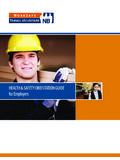
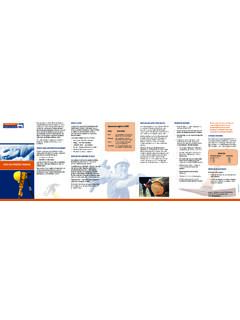
![SAFETY TALK [hearing protection] - WorkSafeNB – …](/cache/preview/3/4/b/8/d/f/0/4/thumb-34b8df04d33dcf40e26b345789106441.jpg)
